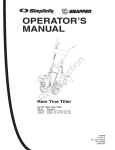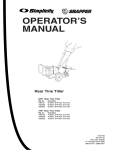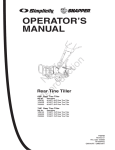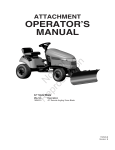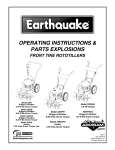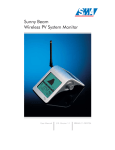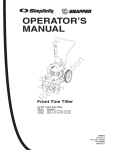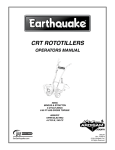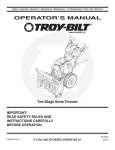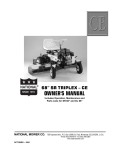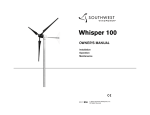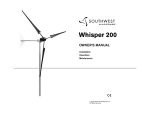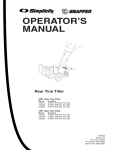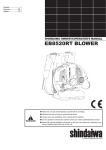Download Operation
Transcript
R N ep o ro t fo du r ct io n OPERATOR’S MANUAL Rear Tine Tiller Mfg. No. Description 1695577 1695583 1695767 1695923 6016RT, 8.5 TP Rear Tine Tiller 6016RT, 8.5 TP Rear Tine Tiller 7016RT, 9.0 TP Rear Tine Tiller 7016RT, 9.0 TP Rear Tine Tiller 1737349 Revision B 2 N ep o ro t fo du r ct io n R Table of Contents 3 4 4 4 4 4 5 5 6 7 Unpack Tiller ............................................................ 7 Attach Handlebar to Tiller ........................................ 7 Fill Engine Crankcase .............................................. 7 FEATURES ................................................................ 8 MAINTENANCE ...................................................... 15 Maintenance Schedule .......................................... 15 Servicing the Rototiller ...........................................15 Change Forward/Reverse Belt ...............................16 Engine Maintenance .............................................. 17 Check or Fill Engine Crankcase ............................ 17 Check Tiller Transmission Grease ......................... 17 Check Tire Pressure .............................................. 17 Lubrication ............................................................. 18 Clean Tine Axle Shaft ............................................ 18 STORAGE ................................................................ 18 Prepare for Storage ............................................... 18 TROUBLESHOOTING .............................................19 Troubleshooting Guide ...........................................19 N ep o ro t fo du r ct io n OPERATION ............................................................... 9 Pre-Start Inspection .................................................. 9 Start-up ................................................................... 9 Idle Speed ............................................................... 10 Operating Speed ..................................................... 10 Shutting Down ........................................................ 10 Tilling ...................................................................... 10 Drive Safety Control Levers .................................. 11 Wheel Lock Pins .................................................. 12 Handlebar Height Adjustment .............................. 12 Depth Regulator Lever ......................................... 13 Belt Tension Adjustment ....................................... 13 Tilling Tips ............................................................. 14 Cultivating Tips ..................................................... 14 TECHNICAL MANUALS .......................................... 21 R WARRANTY............................................................... 22 3 Safety Rules OWNER’S RESPONSIBILITY ! DANGER Accurate assembly and safe and effective use of the rototiller is the owner’s responsibility. s Read and follow all safety instructions. s Carefully follow all assembly instructions. s Maintain the tiller according to directions and schedule included in this Earthquake operator’s manual. s Ensure that anyone who uses the tiller is familiar with all controls and safety precautions. DANGER INDICATES A SERIOUS INJURY OR FATALITY WILL RESULT IF THE SAFETY INSTRUCTIONS THAT FOLLOW THIS SIGNAL WORD ARE NOT OBEYED. ! WARNING WARNING INDICATES A SERIOUS INJURY OR FATALITY COULD RESULT IF THE SAFETY INSTRUCTIONS THAT FOLLOW THIS SIGNAL WORD ARE NOT OBEYED. SPECIAL MESSAGES Your manual contains special messages to bring attention to potential safety concerns, machine damage as well as helpful operating and servicing information. Please read all the information carefully to avoid injury and machine damage. ! CAUTION NOTE: General information is given throughout the manual that may help the operator in the operation or service of the machine. CAUTION INDICATES YOU CAN OR YOUR EQUIPMENT CAN BE HURT IF THE SAFETY INSTRUCTIONS THAT FOLLOW THIS SIGNAL WORD ARE NOT OBEYED. N ep o ro t fo du r ct io n IMPORTANT SAFETY PRECAUTIONS Please read this section carefully. Operate the tiller according to the safety instructions and recommendations outlined here and inserted throughout the text. Anyone who uses this tiller must read the instructions and be familiar with the controls. Your tiller is equipped with a safety device that enables you to stop the wheels and tines quickly in an emergency. Learn how the drive safety control lever operates and how to control the tiller at all times. IMPORTANT IMPORTANT INDICATES HELPFUL INFORMATION FOR PROPER ASSEMBLY, OPERATION, OR MAINTENANCE OF YOUR EQUIPMENT. This symbol points out important safety instructions which if not followed could endanger your personal safety. Read and follow all instructions in this manual before attempting to operate this equipment. s ! WARNING Do not allow children to operate this rototiller. Keep small children away from the area being tilled. Do not allow adults to operate the tiller without proper instruction. PREPARATION Dress appropriately when operating the tiller. Always wear sturdy footwear. Never wear sandals, sneakers, or open shoes, and never operate the tiller with bare feet. Do not wear loose clothing that might get caught in moving parts. s Carefully inspect the area to be tilled and remove all foreign objects. Do not till above underground water lines, gas lines, electric cables, or pipes. Do not operate the tiller in soil with large rocks and foreign objects which can damage the equipment. s Disengage all clutches and leave all control levers in the neutral position before starting the engine. s Handle fuel with care; it is highly flammable. R s a. Use an approved fuel container. b. Never add fuel to a running engine or hot engine. 4 YOU MUST READ, UNDERSTAND AND COMPLY WITH ALL SAFETY AND OPERATING INSTRUCTIONS IN THIS MANUAL BEFORE ATTEMPTING TO SETUP AND OPERATE YOUR ROTOTILLER. FAILURE TO COMPLY WITH ALL SAFETY AND OPERATING INSTRUCTIONS CAN RESULT IN LOSS OF MACHINE CONTROL, SERIOUS PERSONAL INJURY TO YOU AND/OR BYSTANDERS, AND RISK OF EQUIPMENT AND PROPERTY DAMAGE. THE TRIANGLE IN THE TEXT SIGNIFIES IMPORTANT CAUTIONS OR WARNINGS WHICH MUST BE FOLLOWED. CALIFORNIA PROPOSITION 65 WARNING ENGINE EXHAUST FROM THIS PRODUCT CONTAINS CHEMICALS KNOWN TO THE STATE OF CALIFORNIA TO CAUSE CANCER, BIRTH DEFECTS, OR OTHER REPRODUCTIVE HARM. Safety Rules c. Fill fuel tank outdoors with extreme care. Never fill fuel tank indoors. IMPORTANT THE RIGHT AND LEFT SIDES OF YOUR ROTOTILLER ARE DETERMINED FROM THE OPERATING POSITION AS YOU FACE THE DIRECTION OF FORWARD TRAVEL. ENGINE IS SHIPPED FROM FACTORY WITHOUT OIL. YOU MUST ADD ENGINE OIL BEFORE STARTING ENGINE. d. Replace gasoline cap securely and clean up spilled fuel before restarting. s Never attempt to make any adjustments while the engine is running. OPERATION s Never operate the tiller without guards, covers, and hoods in place. s Never start the engine or operate the tiller with the wheels in the free-wheel position. Make sure the wheel lock pins are engaged through the wheel hubs and wheel axle. The wheels act as a brake to keep the tiller at a controlled speed. Disengage wheel lock pins to permit free-wheeling only when engine is stopped. s Keep hands, feet, and clothing away from rotating parts. Keep clear of tiller tines at all times. s5se only attachments and accessories approved by the manufacturer of the tiller. s.ever operate the tiller without good visibility or light. s"E careful when tilling in hard ground. The tines may catch in the ground and propel the tiller backward. If this occurs, let go of the handlebars and do not restrain the machine. sTake all possible precautions when leaving the machine unattended. Disengage all control levers, stop the engine, wait for all moving parts to stop, and make certain guards and shields are in place. N ep o ro t fo du r ct io n s Tines and wheels rotate when tiller is engaged in forward or reverse-- in forward, tines and wheels rotate when the drive safety control lever, labeled “FORWARD”, is pulled toward the handlebar. In reverse, wheels and tines rotate when the drive safety control lever, labeled “REVERSE”, is pulled toward the handlebar. Releasing the drive safety control levers to the neutral position stops the wheels and tines. Do not operate both drive safety control levers at the same time. s.ever allow bystanders near the unit. s Be extremely cautious when operating in reverse. Take extra care to avoid slipping or falling, and keep hands and feet clear of tines. s5SE extreme caution when operating on or crossing gravel drives, walks, or roads. Stay alert for hidden hazards or traffic. s!FTER striking a foreign object, stop the engine, remove the wire from the spark plug, thoroughly inspect the tiller for any damage, and repair the damage before restarting and operating the tiller. R s)FVEGITATION clogs the tines, raise the handlebars to elevate the tines, and run the tiller in reverse. If this does not clean clogged vegetation from the tines, STOP THE ENGINE AND DISCONNECT THE SPARK PLUG WIRE before removing vegetation by hand. s7HEN leaving the operating position for any reason: - shut off the engine. - wait for all moving parts to stop. MAINTENANCE AND STORAGE sKeep machine, attachments, and accessories in safe working condition. s#HEck shear bolts, engine mounting bolts, and other bolts at frequent intervals for proper tightness to be sure the equipment is in safe working condition. sTo prevent accidental starting, always disconnect and secure the spark plug wire from the spark plug before performing tiller maintenance. s.ever run the engine indoors. %XHAUST fumes are deadly. s!Lways allow to cool before fuel tank. sNever store equipment with gasoline in the tank inside a closed or spark. !LLow building where fumes may reach an open the engine to cool before storing in any building. s%NGINE will be hot from operation. Do not touch it with bare skin or a severe burn may result. s!Lways refer to the operator’s guide instructions for important details if the tiller is to be stored for an extended period. s)F the unit should start to vibrate abnormally, stop the engine and check immediately for the cause. Vibration is generally a warning of trouble. s!DD a fuel stabilizer to gas tank and run for 10-15 minutes to prevent fuel from gumming up during an extended storage period. s$O not run the engine indoors; exhaust fumes are deadly. s$O not overload the machine capacity by attempting to till too deep at too fast a rate. sNever operate the machine at high transport speeds on slippery surfaces. Look behind and use care when backing. 5 Safety Rules SAFETY DECALS This rototiller unit has been designed and manufactured to provide you with the safety and reliability you would expect from an industry leader in outdoor power equipment manufacturing. Although reading this manual and the safety instructions it contains will provide you with the necessary basic knowledge to operated this equipment safely and effectively, we have placed several safety labels on the tiller to remind you of this important information while you are operating the unit. These important safety labels are illustrated below, and are shown here to help familiarize you with the location and content of the safety messages you will see as you perform normal tilling operations. Please review these labels now. If you have any questions regarding their meaning or how to comply with these instructions, reread the complete safety instruction text on the preceding pages, or contact your local dealer. Should any of the safety labels become unreadable because of being worn, faded, or otherwise damaged during the use of your tiller, please use the part number information provided to order a replacement label from your local authorized dealer. R N ep o ro t fo du r ct io n The safety labels are easily applied, and will act as a constant visual reminder to you, and others who may use the equipment. Follow the safety instructions necessary for safe, effective operation of your rototiller. Part No. 1716747SM WARNING INSTRUCTIONS Hood Decal Part No. 1716840SM TINES DANGER Hood Flap Decal PLACE FREE HAND HERE Part No. 1716800SM WARNING Belt Cover Decal Part No. 1716839SM FREE HAND HERE Bumper Guard Decal 6 Unpacking and Assembly Your rototiller comes fully assembled except for a few parts. The following instructions will help you unpack your tiller and assemble and adjust your tiller’s depth regulator lever, cable tension and handlebar height. You will need 2- 9/16” wrenches. UNPACK TILLER 1. Open top of carton and remove handlebar assembly. IMPORTANT THE RIGHT AND LEFT SIDES OF YOUR ROTOTILLER ARE DETERMINED FROM THE OPERATING POSITION AS YOU FACE THE DIRECTION OF FORWARD TRAVEL. ENGINE IS SHIPPED FROM FACTORY WITHOUT OIL.YOU MUST ADD ENGINE OIL BEFORE STARTING ENGINE. 2. Find parts packet. Parts packet contains: 4- 3/8-16 x 3/4” hex head bolts 4- 3/8-16 locknuts 1- 5/16-18 x 3/4” hex head bolt 1- detent pin 1- five star knob TILLER TRANSMISSION IS SHIPPED FROM FACTORY WITH THE PROPER AMOUNT OF LIQUID GREASE. 3. Cut open end of car ton and remove machine by: a. Removing lock pins on wheels. b. Roll tiller from carton. ! CAUTION ATTACH HANDLEBAR TO TILLER N ep o ro t fo du r ct io n 1. Place handlebar stems on outside of lower handlebar mount and align lower holes. (SEE FIGURE 1) DO NOT TRY TO LIFT THE ROTOTILLER FROM THE CARTON. DO NOT ADD ENGINE OIL INTO GEAR CASE DIPSTICK HOLE. 2. Insert one 3/8-16 x 3/4” bolt for each side in lower holes at the desired handlebar height. 3. Start 3/8-16 nuts on each bolt. 4. Insert one 3/8-16 x 3/4” bolt for each side in upper holes. 5. Tighten all 3/8-16 nuts. gear case dipstick FILL ENGINE CRANKCASE 1. Add oil according to engine manual. Do not overfill. Use a clean, high quality detergent oil. Container must be marked A.P.I. Service SF - SJ. Use no special additives with recommended oils. Do not mix oil with gasoline. Oil level must be full. Check the oil level by removing oil fill plug. Oil level should be up to the bottom of the fill plug opening. R 2. Always check oil level before starting engine. Refer to engine manual for capacity and type of oil to use. gear case dipstick hole NO ENGINE OIL! 3/8-16 nuts lower handlebar mount 3/8-16 x 3/4” bolts height adjustment holes FIGURE 1 7 handlebar stem Features forward drive safety control lever reverse drive safety control lever bumper guard N ep o ro t fo du r ct io n forward & reverse cable depth regulator lever detent pin R belt guard wheel lock pin recoil start serial number plate 8 Operation PRE-START INSPECTION ! CAUTION 1. Make sure all safety guards are in place and all nuts and bolts are secure. 2. Check oil level in engine crankcase. See your engine manual for procedure and specifications. 3. Inspect air cleaner for cleanliness. See your engine manual for procedure. 4. Check the fuel supply. Fill the fuel tank no closer than 1 inch from top of tank to provide space for expansion. See your engine manual for fuel recommendations. 5. Be sure spark plug wire is attached and spark plug is tightened securely. ! WARNING 6. Check position of wheels and wheel lockouts. 7. Check depth regulator lever position. 8. Examine underneath and around engine for signs of oil or fuel leaks. 9. Inspect fuel hoses for tightness and fuel seepage. START-UP area and recoil starter. The controls required to start and run the rototiller are located on the engine and are marked “Choke” and “Throttle”. A more detailed description of engine operation and all related precautions and procedures can be found in the engine manufacturer’s manual that accompanies each tiller. COLD STARTS WHEELS MUST ALWAYS BE LOCKED IN THE TILLING POSITION WHEN ENGINE IS RUNNING. DO NOT OPERATE THE TILLER WITH THE WHEEL LOCKOUTS UNLOCKED. ALWAYS SET THE WHEELS IN TILLING POSITION BEFORE STARTING ENGINE. ALWAYS PUT THE DEPTH REGULATOR LEVER IN THE TRANSPORT POSITION BEFORE STARTING ENGINE. TINES SHOULD CLEAR THE GROUND. IMPORTANT ENGINE IS SHIPPED FROM FACTORY WITHOUT OIL. YOU MUST ADD ENGINE OIL BEFORE STARTING ENGINE. 1. Move choke lever to full choke position. 2. Move throttle lever to “start”. GASOLINE IS HIGHLY FLAMMABLE AND MUST BE HANDLED WITH CARE. NEVER FILL THE TANK WHEN THE ENGINE IS HOT OR RUNNING. ALWAYS MOVE OUTDOORS TO FILL THE TANK. N ep o ro t fo du r ct io n 10. Look for signs of engine damage. 11. Remove excessive debris from PLEASE DO NOT START YOUR TILLER UNTIL YOU HAVE READ THE MANUAL THAT CAME WITH YOUR ENGINE, AND THE SECTIONS IN THIS MANUAL TITLED CONTROLS, ADJUSTMENTS AND SAFETY. IF YOU HAVE READ THESE, FOLLOW THE STEPS BELOW TO START YOUR TILLER. ALWAYS PERFORM THIS PRE-START CHECKLIST BEFORE STARTING THE ENGINE. 3. Pull starting rope out slowly one time and allow to return normally. ! DANGER 4. Pull starting rope out rapidly, and allow rope to return normally. RESTARTING A WARM ENGINE R 5. When engine starts, gradually move choke lever to “no choke” position and increase throttle speed. Restarting an engine that is already warm from previous running does not normally require use of the choke. 1. Move throttle lever to “start” position. 2. Pull starting rope out rapidly until engine starts. Allow rope to return normally. Repeat until engine starts. 3. Adjust throttle speed to “high” for best tiller action. 9 ALWAYS KEEP HANDS AND FEET CLEAR OF ROTATING MACHINE PARTS. Operation IDLE SPEED Use the “low” position on the throttle lever to reduce stress on the engine when tilling is not being performed. Lowering the engine speed to “idle” will help extend the life of the motor, as well as conserve fuel and reduce the noise level of the equipment. OPERATING SPEED For normal tilling, set the throttle lever to “fast”. SHUTTING DOWN To stop the engine at any time, move throttle control to the off position. To stop wheels and tines at any time, release drive safety control levers to neutral position. TILLING ! WARNING TEMPERATURE OF MUFFLER AND NEAR BY AREAS MAY EXCEED 150 F. AVOID THESE AREAS. DO NOT MOVE CHOKE CONTROL TO CHOKE TO STOP ENGINE. BACKFIRE OR ENGINE DAMAGE MAY OCCUR. TO STOP WHEELS AND TINES AT ANY TIME, RELEASE DRIVE SAFETY CONTROL LEVERS TO NEUTRAL POSITION. ALWAYS RELEASE DRIVE SAFETY CONTROL LEVERS TO NEUTRAL POSITION BEFORE ADJUSTING THE DEPTH OF THE REGULATOR LEVER. 1. Adjust the depth regulator lever to desired tilling depth. NOTE: Raise depth regulator lever up one hole at a time, testing tiller operation after each raise. Raising depth regulator lever too high can result in loss of control of tiller! N ep o ro t fo du r ct io n 2. Move the throttle control to fast. ! DANGER ENGINE AND SURROUNDING PARTS BECOME EXTREMELY HOT DURING NORMAL USE AND WILL CAUSE SERIOUS BURN INJURIES IF TOUCHED BEFORE THE ENGINE HAS COOLED. 3. Place the tiller in forward by pushing down on the drive safety control lever labeled “FORWARD”--this will engage the wheels and tines. NOTE: You can slow the tiller’s forward advance at any time by putting slight downward pressure on the handlebars. You can stop the tiller by releasing the drive safety control levers to the neutral position. ALLOW ENGINE TO COOL COMPLETELY BEFORE TOUCHING THESE HOT SURFACES. IMPORTANT R PRACTICE OPERATING THE CONTROLS AND TILLER WITH TINES OUT OF GROUND BEFORE BEGINNING TO TILL. IT IS IMPORTANT THAT YOU KNOW HOW TO USE THE TILLER PROPERLY, KEEP CONTROL AT ALL TIMES, STOP THE TINES AND WHEELS FROM TURNING, AND STOP THE ENGINE IF NECESSARY. IF YOU DO NOT KNOW HOW TO DO THESE THINGS, READ THE CONTROLS, ADJUSTMENTS AND SAFETY SECTIONS BEFORE PROCEEDING. 10 Operation DRIVE SAFETY CONTROL LEVERS ! CAUTION FORWARD LEVER DO NOT OPERATE BOTH “FORWARD” AND “REVERSE” DRIVE SAFETY CONTROL LEVERS AT THE SAME TIME. Engages wheels and tines into forward. Pulling the drive safety control lever labeled (FORWARD) toward the handlebar engages the wheels and tines. Releasing the lever stops the wheels and tines and brings the tiller to a complete stop. THIS INFORMATION IS PROVIDED HERE ONLY TO INTRODUCE THE CONTROLS. DO NOT START THE ENGINE AT THIS TIME. STARTING AND OPERATING INSTRUCTIONS ARE GIVEN ON PAGE 8. PLEASE READ THIS SECTION AND ALL OPERATING AND SAFETY INSTRUCTIONS BEFORE STARTING YOUR TILLER. forward lever engaged s AS A SAFETY PRECAUTION, THE DRIVE SAFETY CONTROL LEVERS WILL NOT LOCK IN THE FORWARD OR REVERSE POSITION. s AS A SAFETY PRECAUTION, THE REVERSE DRIVE SAFETY CONTROL LEVER WILL NOT LOCK IN REVERSE. REVERSE LEVER N ep o ro t fo du r ct io n s TO STOP THE WHEELS AND TINES AT ANY TIME RELEASE THE DRIVE SAFETY CONTROL LEVERS OR RELEASE THE REVERSE HANDLE. Engages wheels and tines into reverse. s DO NOT OPERATE BOTH THE REVERSE AND FORWARD DRIVE SAFETY CONTROL LEVERS AT THE SAME TIME. Pulling the drive safety control lever labeled (REVERSE) toward the handlebar reverses tiller. Releasing the lever stops the wheels and tines. reverse lever engaged ! WARNING ENGINE SHOULD BE OFF BEFORE ADJUSTING ANY CONTROLS. R EXTREME CAUTION SHOULD BE USED WHEN OPERATING ROTOTILLER IN THE REVERSE DIRECTION. reverse lever 11 Operation WHEEL LOCK PINS ! WARNING Place wheels in tilling position. 1. Remove lock pin. Align hole in axle with hole in wheel hub. (SEE FIGURE 2) 2. Insert lock pin through holes, fold lock pin ring to secure pin to axle. 3. Firmly lock wheel and axle together before tilling. NEVER START ENGINE OR OPERATE TILLER WITH WHEELS IN FREE-WHEEL POSITION. THE FREEWHEEL POSITION IS FOR TRANSPORTING THE TILLER LONG DISTANCES OVER LEVEL GROUND-DO NOT ATTEMPT TO MOVE THE TILLER UP OR DOWN STEEP GRADES IN THE FREE-WHEEL POSITION. 4. Repeat for other wheel. NOTE: Always have both wheel lock pins in or out. Do not operate tiller with only one wheel locked. To place wheels in free-wheel position. 1. Remove lock pin. Slide wheel inward toward machine. 2. Insert pin in axle only. 3. Wheel should turn freely on axle. HANDLEBAR HEIGHT ADJUSTMENT Adjust handlebar height. Wheel lock pin in free-wheel position. (axle hole only) N ep o ro t fo du r ct io n The ideal height of the handlebar varies with operator height and the depth of tilling. To adjust handlebar height: (SEE FIGURE 3) 1. Unscrew nuts and remove top and bottom bolts on each side. FIGURE 2 2. Align handlebar to desired holes on the lower handlebar mount. lock nuts R 3. Install bolts and nuts. Retighten. height adjustment bolts height adjustment holes FIGURE 3 11 height adjustment bolts Operation DEPTH REGULATOR LEVER Tilling depth is controlled by the height of the depth regulator lever. ! WARNING DO NOT ADJUST TILLING DEPTH UNLESS DRIVE SAFETY CONTROL LEVERS ARE RELEASED TO NEUTRAL POSITION. To adjust tilling depth. (SEE FIGURE 4) 1. Remove detent pin. 2. Raise the depth regulator lever to position tines at chosen tilling depth. 3. Align hole in depth regulator lever with hole in depth regulator bracket and replace detent pin. ALWAYS SET THE DEPTH REGULATOR LEVER IN THE TRANSPORT POSITION BEFORE STARTING ENGINE, THAT IS, PLACE THE DETENT PIN IN THE HIGHEST HOLE OF THE DEPTH REGULATOR LEVER. Depth Regulator Lever Down = Shallower tilling. Place the detent pin in the top hole of the depth regulator lever for shallowest tilling. Depth Regulator Lever Up = Deeper tilling. Place the detent pin in the bottom hole of the depth regulator lever for deepest tilling. BELT TENSION ADJUSTMENT Proper belt tension is critical to good performance. After 1/2 hour of operation, all cables may have to be adjusted due to initial stretch. Thereafter, check tension after every 2 hours of operation. N ep o ro t fo du r ct io n detent pin To increase belt tension: (SEE FIGURE 5) 1. Loosen upper jam nut. Turn nut up cable in 1/8” increments. 2. Tighten lower jam nut. 3. Check adjustment. depth regulator bracket This procedure can be repeated until conduit adjustment bolts are fully adjusted. If no more adjustment can be made, belt may have to be replaced. depth regulator lever R FIGURE 4 forward cable reverse cable upper jam nut lower jam nut FIGURE 5 12 Operation TILLING TIPS ! WARNING The key to successful tilling is to begin with a shallow cut on the first pass, and then work an inch or two deeper on each successive pass. EXTREME CAUTION MUST BE TAKEN IN SELECTING TILLING DEPTH. IF YOU ATTEMPT TO TILL TOO DEEPLY FOR SOIL CONDITIONS, THAT IS, WITH THE DRAG STAKE IN TOO HIGH A POSITION, LOSS OF CONTROL COULD RESULT. s4ILLING depth WILL vary WITH gROUND CONDITIONs. s7HEN BEGINNING to TILL IN UNBROkEN gROUND or IN eXTREMELY hard SOIL set the DETENT PIN IN the HIGHEST HOLE of the drag stake (fOLLow INSTrUCTIONS UNDER 4ILLING SECTION. 4HIS WILL ALLow for SHALLow TILLING. 7ITH the drag stake IN THIS POSITION make severAL LIGHT passes over the area to be TILLED. Reset for deeper depths WITH SUCCESSIve passes. IF REMOVING MATERIAL FROM THE TINES BY HAND, STOP ENGINE AND REMOVE SPARK PLUG WIRE FIRST. sIf tILLer jumps or skIds UNCONTROLLabLy Lower the drag stake by pLaCINg the DETENT PIN IN a HIGHER HOLe. 4HIS WILL ALLow for SHALLower TILLING. (OLD to the HANDLEBARS to CONTROL SUDDEN LURCHEs. s weeds If TALL grasses VINEs or other materIALS CLOG or jam the TINEsRevERSETHETILLERTOUNWINDvEGETATION CULTIVATING TIPS N ep o ro t fo du r ct io n Immediately release the drive control levers if the tines jam or you strike a foreign object. With drive control levers in neutral position, push throttle control to stop position to stop the engine. Disengage the spark plug wire. When tines have stopped, remove foreign objects and check for damage. If you PLAN to use your TILLER for CULTIvATING s0LANT rows ON 20" - 22" CENTERS for ease of turNING R sSet the depth REGULATOr Lever WITh the DETENt PIN IN ONe of the HIGHEr HOLEs. 4HIS WILL ALLow for SHALLow CULTIvATION NECESSAry to turN over weedsANDBREAKUPANDAErATETHESOIL 14 Maintenance MAINTENANCE SCHEDULE Your rototiller has been designed and produced by the industry’s leading manufacturer of outdoor power equipment to provide you with years of reliable operation. Keeping your tiller in top running condition will prolong its life, and help you obtain optimum performance. Please read this normal care schedule, and note the recommended care operating intervals to extend the life of your unit. Maintenance Operation Page Before Each Use 50 hours or Every Season Change forward/reverse belt 16 Engine maintenance 17 X X 17, EM X 2 Check tiller transmission grease 18 X Check tire pressure 18 X Lubrication Clean tine axle shaft Lubricate wheel axle shaft Check throttle control adjustment EM = See engine manual N ep o ro t fo du r ct io n Check or fill engine crankcase X 18 X 18 X 19 X EM 1 1 Adjust throttle control after first 3 hours of operation or if engine is hard to start or run-on occurs. R 2 Change oil after first 5-8 hours of use, then after every 50 hours or every season. Change oil every 25 hours when operating under heavy load or in high temperatures. SERVICING THE ROTOTILLER The following information will help you make the necessary checks and perform the procedures required to follow the normal care recommendations made for your rototiller unit. ! WARNING To prevent accidental starting: If you prefer, your local authorized dealer can make these checks and perform the required procedures for you. Engine must be turned off and cool, and spark plug wire must be removed and secured from spark plug before checking and adjusting engine or equipment. 15 Maintenance CHANGE FORWARD/REVERSE BELT ! CAUTION 1. Turn off engine. Engine must be cool. DO NOT OPERATE TILLER BEFORE READING THE ENGINE MANUAL PROVIDED IN THE PARTS PACKET. 2. Remove spark plug wire and secure from spark plug. 3. Remove belt guard. sREMove the forward belt from the forward engine pulley: - gently pull the engine recoil rope to rotate the pulley. ! WARNING - with the pulley turning, force the forward belt out of the V-groove. TEMPERATURE OF MUFFLER AND NEAR BY AREAS MAY EXCEED 150° F. AVOID THESE AREAS. - slide the belt free of the engine pulley. - pull the forward belt down and out of the way. sREMove the reverse belt from the reverse engine pulley: - gently pull the engine recoil rope to rotate the pulley. IMPORTANT - with the pulley turning, force the reverse belt out of the V-groove. ENGINE CAN OVERHEAT AND BECOME DAMAGED IF DEBRIS BLOCKS THE COOLING SYSTEM OR ROTATING SCREEN. - slide the belt free of engine pulleys and reverse belt guides. NEVER RUN ENGINE WITHOUT COMPLETE AIR CLEANER INSTALLED ON ENGINE. sINSTALL new reverse belt: N ep o ro t fo du r ct io n - pull belt down and away from transmission pulley. NOTE: V side of belt should be up, away from pulley. - thread belt up from bottom. - place belt around transmission pulley in groove. - place belt under reverse belt guides. - gently pull engine recoil rope while forcing the belt over the edge of the engine pulley into the V-groove. sINSTALL new forward belt: - place forward belt in transmission pulley groove. 4. Replace belt guard. 5. Attach spark plug wire. R - gently pull the engine recoil rope to rotate the pulley while forcing the forward belt into the V-groove. Reverse Belt, V side up ENGINE PULLEY Forward Belt 16 TRANSMISSION PULLEY Maintenance ENGINE MAINTENANCE Refer to the engine manual included in your parts packet for information on engine maintenance. Your engine manual provides detailed information and a maintenance schedule for performing the following tasks: 1. Check oil level before each use or after every 8 hours of operation. 2. Change oil after first 5-8 hours of operation. Change oil while engine is warm. Refill with new oil of recommended grade. 4. Check spark plug yearly or every 100 hours of operation. IMPORTANT ENGINE IS SHIPPED FROM FACTORY WITHOUT OIL. YOU MUST ADD ENGINE OIL BEFORE STARTING ENGINE. IMPORTANT TILLER TRANSMISSION IS SHIPPED FROM FACTORY WITH THE PROPER AMOUNT OF LIQUID GREASE. 5. Service air cleaner. 6. Keep engine and parts clean. 7. Check engine and equipment often for loose nuts and bolts, keep these items tightened. WHEN REPLACING GREASE, THE TILLER TRANSMISSION HOLDS 18-22 OUNCES. DO NOT OVERFILL. CHECK OR FILL ENGINE CRANKCASE N ep o ro t fo du r ct io n 1. Add oil according to engine manual. Do not overfill. Use a clean, high quality detergent oil. Container must be marked A.P.I. Service SF - SJ. Use no special additives with recommended oils. Do not mix oil with gasoline. Oil level must be full. Check the oil level by removing oil fill plug. Oil level should be up to the bottom of the fill plug opening. 2. Always check oil level before starting engine. Refer to engine manual for capacity and type of oil to use. gear case dipstick CHECK TILLER TRANSMISSION GREASE Check the grease level annually. To check the grease level: 1. Move tiller to level ground. 2. Remove grease level dipstick located between the handlebar mounts on the engine mount. Correct grease level is indicated between the high and low levels on the dipstick. 3. Replace grease level dipstick in the filler hole. R 4. Note that the front wheel transmission and rear tine transmission are one common reservoir. When you add to the front transmission, you must wait a short period of time for the grease to rearward and equalize in both front and rear. The dipstick will read correctly on level ground for both gear units. CHECK TIRE PRESSURE Recommended tire pressure is 20 PSI. If tires do not have equal pressure, tiller will pull to one side. 17 transmission cover plate Maintenance LUBRICATION Proper lubrication of moving mechanical parts is critical for proper care and maintenance. Oil the moving parts at 10 hour intervals using a 30 weight oil. CLEAN TINE AXLE SHAFT 1. Turn off engine. Engine must be cool. 2. Remove spark plug wire and secure from spark plug. ! WARNING DO NOT STORE TILLER IN AN UNVENTILATED AREA WHERE FUEL FUMES MAY REACH FLAME, SPARKS, PILOT LIGHTS OR AN IGNITED OBJECT. DRAIN FUEL OUTDOORS AWAY FROM ANY IGNITION SOURCES. USE ONLY APPROVED FUEL CONTAINERS. 3. Tip the tiller forward. Block the tiller in position so that it rests on the engine mount and the tines are exposed. 4. Remove all vegetation, string, wire, and other material that may have accumulated on the axle between the inside set of tines and the seal on the transmission housing. 5. Tip the tiller back to a level position. 6. Replace spark plug wire. STORAGE PREPARE FOR STORAGE N ep o ro t fo du r ct io n Follow the steps below to prepare your tiller for storage. Read your engine manual for detailed instructions on preparing the engine for storage. 1. Protect wheels and axles from rust: - Remove lockpin and slide wheel off hub. - Coat the axles lightly with axle grease. - Slide wheel back on hub and insert lock pin. 2. Drain fuel system completely following engine manufacturer’s instructions or add fuel stabilizer to prevent fuel from gumming up during extended storage period. 3. While engine is still warm, drain the oil from the engine. Refill with fresh oil of the recommended grade. 4. Clean external surfaces, engine and cooling fan. R 5. Remove spark plug, pour one ounce of SAE 30 oil into spark plug hole. 6. Plug hole and pull starter cord slowly to distribute oil evenly in cylinder head area. 7. Reinstall spark plug. 8. Transport unit to a suitable storage location. If you have chosen to use a fuel stabilizer and have not drained the fuel system, follow all safety instructions storage precautions in this manual to prevent the possibility of fire from the ignition of gasoline fumes. Remember, gasoline fumes can travel to distant sources of ignition and ignite, causing risk of explosion and fire. 9. If there is any possibility of unauthorized use or tampering, remove the spark plug and store it in a safe place before storing the rototiller unit. Be sure to plug the spark plug hole to prevent foreign material from entering. 18 Maintenance TROUBLESHOOTING GUIDE ! WARNING While normal care and routine maintenance will extend the life of your rototiller, prolonged or constant use may eventually require that service be performed to allow it to continue operating properly. The troubleshooting guide below lists the most common problems, causes and remedies. PRACTICE SAFETY AT ALL TIMES. ENGINE MUST BE TURNED OFF AND ALLOWED TO COOL, AND SPARK PLUG WIRE MUST BE DISCONNECTED AND SECURED BEFORE ATTEMPTING ANY MAINTENANCE OR REPAIR. FAILURE TO COMPLY WITH THIS SAFETY REQUIREMENT CAN RESULT IN SERIOUS PERSONAL INJURY TO YOU OR BYSTANDERS. PROBLEM s!DD gas to gas tank. s#ONNECT spark plug wire to spark plug s4HROTTLE must be positioned at choke for a cold start Engine will not start Engine runs rough, REMEDY/ACTION during operation s#LEAN or replace air cleaner s$rain old fuel and replace with fresh. Use gas stabilizer at end of season s-Ake sure spark plug wire is securely attached to spark plug s$rive safety control levers must be released to neutral position to start the engine N ep o ro t fo du r ct io n Engine is hard to start s2AISE the tines for shallow tilling by lowering the depth regulator lever s2EMove and clean fuel tank s#LEAN or replace air cleaner s)MPROPER carburetor adjustment, take to authorized engine service center s2EPLACE spark plug and adjust gap s$rain and gas tank and carburetor Engine misses or lacks power R Engine will not stop when throttle control is positioned at stop s3EE engine manual to check and adjust throttle linkage Tiller moves forward during starting s$rive safety control levers must be released to neutral position to start the engine Tiller is difficult to control when tilling (machine jumps or lurches forward) s,Ock wheels in tilling position s2AISE the tines for shallower tilling by lowering the depth regulator lever Tines turn, wheels do not turn s,Ock wheels in tilling position s)NTErnal transmission failure, see your dealer Tines turn, wheels turn, tiller does not move s,ower the tines for deeper tilling by raising the depth regulator lever 19 Maintenance PROBLEM REMEDY/ACTION s Adjust forward belt guide: - turn engine off and allow to cool - disconnect spark plug wire and secure from spark plug - remove belt guard - pull down on drive safety control levers - manually bend forward belt guide so there is 1/16 inch or less clearance between belt guide and belt - replace belt guard and spark plug wire Belts squeal in forward operation s Adjust tabs on the reverse belt guide to cool - turn engine off and allow - disconnect spark plug wire and secure from spark plug - release drive safety control levers to neutral position - remove belt guard - adjust tabs of reverse belt guide: while drive safety control levers are released, bend metal tabs on reverse belt guide to 1/64 inch or less clearance from reverse belt - replace belt guard and spark plug wire N ep o ro t fo du r ct io n Belts squeal in neutral and/or reverse s Remove vegetation by following instructions in Clean Tine Axle Shaft of Normal Care section. FOLLOW ALL SAFETY INSTRUCTIONS s Check transmission and if needed R Excessive heat build up in transmission/tine area during tilling 20 Technical Manuals Additional Technical Literature Available Additional copies of this manual are available, as well as fully illustrated parts lists. These manuals show all of the product’s components in exploded views (3D illustrations which show the relationship of parts and how they go together) as well as part numbers and quantities used. Important assembly notes and and torque values are also included. R N ep o ro t fo du r ct io n Technical manuals can be downloaded from: www.simplicitymfg.com www.snapper.com. 21 BRIGGS & STRATTON POWER PRODUCTS GROUP, L.L.C. OWNER WARRANTY POLICY LIMITED WARRANTY Briggs & Stratton Power Products Group, LLC will repair and/or replace, free of charge, any part(s) of the equipment that is defective in material or workmanship or both. Briggs & Stratton Corporation will repair and/or replace, free of charge, any part(s) of the Briggs and Stratton engine* (if equipped) that is defective in material or workmanship or both. Transportation charges on product submitted for repair or replacement under this warranty must be borne by purchaser. This warranty is effective for the time periods and subject to the conditions stated below. For warranty service, find the nearest Authorized Service Dealer using our dealer locator at www.BriggsandStratton.com or www.Murray.com. There is no other express warranty. Implied warranties, including those of merchantability and fitness for a particular purpose, are limited to one year from purchase or to the extent permitted by law. Liability for incidental or consequential damages are excluded to the extent exclusion is permitted by law. Some states or countries do not allow limitations on how long an implied warranty lasts, and some states or countries do not allow the exclusion or limitation of incidental or consequential damages, so the above limitation and exclusion may not apply to you. This warranty gives you specific legal rights and you may also have other rights which vary from state to state or country to country. WARRANTY PERIOD Item Equipment Engine* Battery Consumer Use 2 Years 2 Years 1 Year Commercial Use: 90 Days 90 Days 1 Year N ep o ro t fo du r ct io n The warranty period begins on the date of purchase by the first retail consumer or commercial end user, and continues for the period of time stated above. “Consumer use” means personal residential household use by a retail consumer. “Commercial use” means all other uses, including use for commercial, income producing or rental purposes. Once product has experienced commercial use, it shall thereafter be considered as commercial use for purposes of this warranty. No warranty registration is necessary to obtain warranty on Briggs & Stratton products. Save your proof of purchase receipt. If you do not provide proof of the initial purchase date at the time warranty service is requested, the manufacturing date of the product will be used to determine warranty eligibility. ABOUT YOUR WARRANTY We welcome warranty repair and apologize to you for being inconvenienced. Warranty service is available only through servicing dealers authorized by Briggs & Stratton or BSPPG, LLC. Most warranty repairs are handled routinely, but sometimes requests for warranty service may not be appropriate. This warranty only covers defects in materials or workmanship. It does not cover damage caused by improper use or abuse, improper maintenance or repair, normal wear and tear, or stale or unapproved fuel. R Improper Use and Abuse - The proper, intended use of this product is described in the Operator’s Manual. Using the product in a way not described in the Operator’s Manual or using the product after it has been damaged will void your warranty. Warranty is not allowed if the serial number on the product has been removed or the product has been altered or modified in any way, or if the product has evidence of abuse such as impact damage, or water/chemical corrosion damage. Improper Maintenance or Repair - This product must be maintained according to the procedures and schedules provided in the Operator’s Manual, and serviced or repaired using genuine Briggs & Stratton parts. Damage caused by lack of maintenance or use of non-original parts is not covered by warranty. Normal Wear - Like all mechanical devices, your unit is subject to wear even when properly maintained. This warranty does not cover repairs when normal use has exhausted the life of a part or the equipment. Maintenance and wear items such as filters, belts, cutting blades, and brake pads (engine brake pads are covered) are not covered by warranty due to wear characteristics alone, unless the cause is due to defects in material or workmanship. Stale Fuel - In order to function correctly, this product requires fresh fuel that conforms to the criteria specified in the Operator’s Manual. Damage caused by stale fuel (carburetor leaks, clogged fuel tubes, sticking valves, etc) is not covered by warranty. * Applies to Briggs and Stratton engines only. Warranty coverage of non-Briggs and Stratton engines is provided by the engine manufacturer. EN 1737660 Rev B N ep o ro t fo du r ct io n R N ep o ro t fo du r ct io n R www.simplicitymfg.com www.snapper.com Briggs & Stratton Power Products Group, L.L.C. Copyright © 2011 Briggs & Stratton Corporation Milwaukee, WI USA. All Rights Reserved www.BRIGGSandSTRATTON.com
























